Multiple Choice
Identify the
choice that best completes the statement or answers the question.
|
|
|
1.
|
One 7.0 kg bowling ball is lifted to a storage shelf 1.0 m above the floor. A
second 7.0 kg ball is lifted to a storage shelf 2.0 m above the floor. Which of the following best
explains why the measured force of gravity on each ball is nearly identical? (MCAS 2006)
a. | The final potential energy of each ball increased. | b. | The amount of work
required to lift each ball is identical. | c. | The distance of each ball from Earth’s
center of mass is almost identical. | d. | The gravitational force of each ball on the
other cancels out the force of Earth’s gravity. |
|
|
|
2.
|
The Sun’s gravitational attraction causes a comet’s path to curve as
shown in the diagram below. 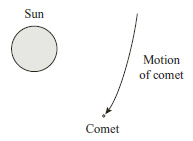 Which of the following statements best
explains the fact that the Sun does not appear to move due to the comet’s gravitational
attraction? (MCAS 2006)a. | The Sun’s mass is much greater than the comet’s mass.
| b. | The comet is too far away for its gravity to affect the Sun. | c. | In this
gravitational interaction only the comet exerts a pull on the Sun. | d. | The path of the
comet reduces the Sun’s gravity. |
|
|
|
3.
|
The diagram below represents two identical space
ships, Earth, a space station, and the Moon.  The two ships are
launched toward the Moon. Ship 1 is launched from Earth, and ship 2 is launched from the space
station. It takes less force to launch ship 2. Which of the following contributes most to the
difference in the forces? (MCAS 2007)a. | Ship 2 has less inertia in space than ship 1 does on Earth. | b. | Earth exerts less
gravitational force on ship 2 than on ship 1. | c. | Ship 2 must travel a shorter distance than ship
1 before reaching the Moon. | d. | The Moon exerts more gravitational force on
ship 2 than on ship 1. |
|
|
|
4.
|
The illustration below shows an athlete participating in an Olympic hammer throw
event.  The athlete twirls the hammer (a heavy
steel ball attached to a wire) around several times before releasing it. The diagram below shows the
path of the ball as it is spun in a circle before its release. 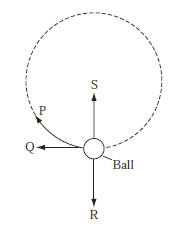 Which
arrow shows the direction of the centripetal force on the ball before the ball is released?
(MCAS 2008)
|
|
|
5.
|
The distance of the star Vega from Earth is 1.6 million times greater than the
distance of the Sun from Earth. Which of the following best describes the gravitational
influence of Vega on Earth? (MCAS 2008)
a. | It is roughly equal to that of the Sun. | b. | Its influence is
greater than that of the Sun. | c. | Its influence is small because of its
distance. | d. | It influences the magnitude of Earth’s mass. |
|
|
|
6.
|
The diagram below shows a ball moving in a circular
path.
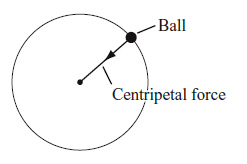
Which of the following would cause the
ball to fly off in a straight-line path? (MCAS 2009)
a. | decreasing the mass of the
ball | b. | changing the velocity of the
ball | c. | increasing the radius of the balls
path | d. | removing the centripetal force on the
ball |
|
|
|
7.
|
Tides, such as those along the coast of Massachusetts, are caused by
gravitational attractions acting on Earth. Why is the gravitational attraction of the Moon a greater
factor in determining tides than the gravitational attraction of the much larger Sun? (MCAS 2004)
a. | Earth is much closer to the Moon than to the Sun. | b. | The Sun’s
gravity is a factor only during the day. | c. | The Moon’s core has a much greater
density than the Sun’s core. | d. | The Sun’s mass is smaller than the mass
of the Moon. |
|
|
|
8.
|
Which of the following statements best describes the force of
Earth’s gravity on a rocket moving upward? (MCAS
2010)
a. | The gravitational force is constant for all altitudes. | b. | The gravitational
force is weaker when the rocket is higher. | c. | The gravitational force is stronger when the
rocket is higher. | d. | The gravitational force is zero when the
altitude is greater than 10,000 miles. |
|
|
|
9.
|
Which of the following statements describes a result of Earth’s
gravitational pull on the Moon? (MCAS 2010)
a. | The Moon has craters. | c. | The Moon lacks an atmosphere. | b. | The Moon orbits
around Earth. | d. | The Moon has
less gravity than Earth. |
|
|
|
10.
|
The diagram below shows a comet in an elliptical orbit around a star. 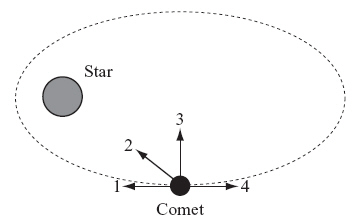 Which arrow indicates the direction of the gravitational force the star exerts on the
comet when the comet is in the position shown? (MCAS 2011)
|
|
|
11.
|
A boy has a ball on a string. He swings the ball in a circle above his head. The
diagram below is a top view of this situation. 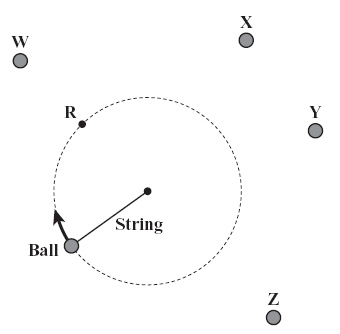 If the boy releases the
string when the ball is at position R, at which point will the ball land? (MCAS 2011)a. | point W | b. | point X | c. | point Y | d. | point
Z |
|
|
|
12.
|
According to Newton’s law of universal gravitation, in which of the
following situations does the gravitational attraction between two bodies always
increase? (MCAS 2012)
a. | The masses increase, and the distance between the centers of mass
increases. | b. | The masses increase, and the distance between the centers of mass
decreases. | c. | The masses decrease, and the distance between the centers of mass
increases. | d. | The masses decrease, and the distance between the centers of mass
decreases. |
|
|
|
13.
|
A ball is thrown upward at an angle from position P. The diagram below shows the
position of the ball at equal time intervals as it moves from position P to position Q. 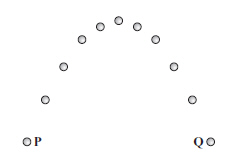 Which of the following causes the change in the ball’s velocity as the ball
travels from position P to position Q? (MCAS 2012)a. | decrease in its inertia | c. | downward force of
gravity | b. | increase in its momentum | d. | initial acceleration upward |
|
|
|
14.
|
The diagram below shows an object traveling at a constant speed in a circular
path. 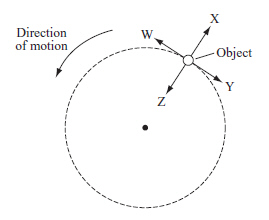 Which labeled arrow represents the
centripetal force acting on the object? (MCAS 2012)
|
|
|
15.
|
A student researches Jupiter and Saturn and records the following information:
• Jupiter is about half the distance to the Sun that
Saturn is.
• Jupiter is about three times more
massive than Saturn.
Based on this information, which of the following can be concluded about the
gravitational forces between these planets and the Sun? (MCAS
2013)
a. | There are no gravitational forces between Jupiter and the Sun or between Saturn and
the Sun. | b. | There are equal gravitational forces between Saturn and the Sun and between Jupiter
and the Sun. | c. | There is a greater gravitational force between Jupiter and the Sun than between
Saturn and the Sun. | d. | There is a greater gravitational force between
Saturn and the Sun than between Jupiter and the Sun. |
|
|
|
16.
|
The diagram below shows a ball tied to a string. A student is swinging the ball
in a horizontal circle. 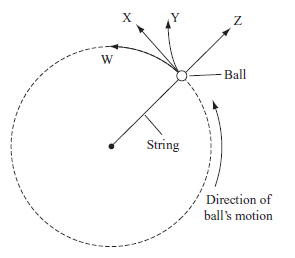 If the student releases the string, in
which direction will the ball travel? (MCAS 2013)a. | direction W | b. | direction X | c. | direction Y | d. | direction
Z |
|
|
|
17.
|
The Moon was much closer to Earth 4.6 billion years ago. Which of the following
statements describes the gravitational interaction of Earth and the Moon 4.6 billion years ago? (MCAS 2014)
a. | The gravitational force of the Moon on Earth was larger than the force is
now. | b. | The gravitational force of Earth on the Moon was the same as the force is
now. | c. | The gravitational force of the Moon on Earth was smaller than the force is
now. | d. | The gravitational force of Earth on the Moon was smaller than the force is
now. |
|
|
|
18.
|
A space station moves in a circular orbit around Earth. Which of the following
statements describes the centripetal force acting on the space station? (MCAS 2014)
a. | The force is acting in the direction of motion. | b. | The force is
directed toward the space station. | c. | The force is directed toward the center of
Earth. | d. | The force is acting opposite the direction of motion. |
|
Essay
|
|
|
19.
|
An attractive force is responsible for keeping
satellites in orbit around Earth. The table below gives the masses of seven satellites and the
distances between each of these satellites and the center of Earth. (MCAS 2009)
Satellite | Mass (kg) | Distance between Satellite
and Center
of Earth (km) | 1 | 50 | 7,000 | 2 | 100 | 14,000 | 3 | 200 | 7,000 | 4 | 200 | 14,000 | 5 | 400 | 14,000 | 6 | 400 | 28,000 | 7 | 800 | 28,000 | | | |
a.
Identify the attractive force that holds satellites in orbit.
b. Explain why satellite 3 does not experience the same amount
of attractive force as satellite 1.
c. Identify one other
satellite that experiences the same amount of attractive force as satellite 4, and explain why
satellite 4 and the satellite you identified experience the same attractive
force.
|